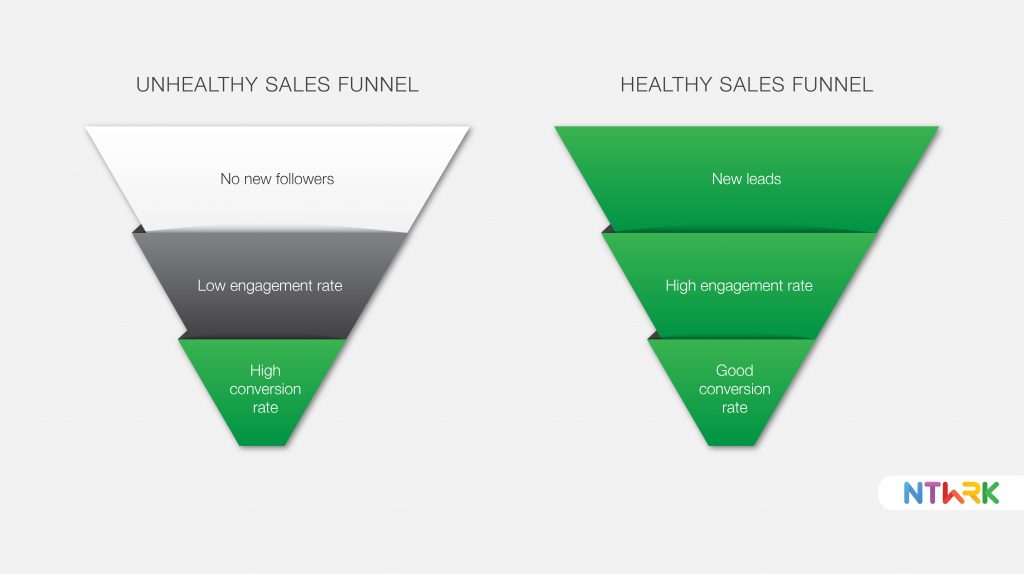You’ve Got (e)Mail Marketing
Email marketing sometimes gets a bad rep among audiences. More often than not, subscriber emails are very quickly relocated into the trash folder or marked as spam. But like its spiritual successor, the app notification, email marketing is all about moving your audience towards an action you want them to take by engaging with them. To achieve growth in this area, it’s helpful to think of your email activities like a typical sales funnel.
A sales funnel only thrives and grows when all three sections; top (gathering leads), middle (engaging with the leads), and bottom (getting the leads to convert) are kept at a healthy state. If one of these sections is performing badly, it leads to a funnel collapse, and your email efforts go nowhere.

Great email marketing teams monitor these three sections of their funnel and optimise accordingly. The equation is often boiled down to: new leads + high engagement + good conversion rates = long term growth opportunities.
Let’s take a look at this section by section:
Starting from the top
Like your sales funnel, the top of the email marketing funnel consists of lead acquisition. It represents a vital communication tool for engaging your audience. This is where your audience gets its first taste of the content your brand offers.
Using the email entered by users when they register for accounts on your website isn’t enough. Up your email marketing game with some of these options:
- On-site subscription bars: Motivate your audience to subscribe to your newsletters with exclusive offers and deals.
- Subscriber capture overlays: Pop-ups call attention to your newsletter or your reader list and drive a more immediate response to engagement and lead acquisition.
- Offline email collection: For brands that have physical stores, having an email list of existing buyers allows you to continue offering products and discounts based on their purchasing history.
In other words: create easily accessible paths for your audience to enter your email list.
Marketing in the middle
Email marketing campaigns falls within one of three categories:
- Inform/Educate
- Build/Sustain brand engagement
- Ad hoc campaigns
These email variants are often seen as progressing phases of engagement.
Informative campaigns centre around creating welcome newsletters or deploying automation that is executed when a new user/reader is added to the list. This acts as a helpful introduction to your brand.
Sustaining brand engagement is the bread and butter of email marketing. This is the newsletter your brand pours its heart and soul into to keep your audience engaged. Balancing out the right mailing frequency and content like weekly promotional offers or new products maintains consistent audience interest and engagement.
Lastly, ad hoc campaigns are a great way of driving the desired action. These campaigns are most ideal for RSVP-ing to an event, birthday wishes for your customers, VIP campaigns, or loyalty programmes. However, while great as supplementary marketing, they should never be replacements for brand engagement emails.
Keeping an open and constant line of engagement with your audience is key to consistent and sustainable growth.
Building on the bottom
If a sales funnel is about delivering a hook, line, and sinker, this is where the sinker is the most important. When focusing your efforts of driving leads into conversions, it’s important to consider the barriers that might prevent your customers from converting. High prices, poorly designed websites, and slow loading times are some of the main reasons leads fail to complete the conversion process. Bottom funnel emails are a method to overcome these barriers.
Ad hoc campaigns
As mentioned, ad hoc campaigns are a great way of focusing on driving targeted conversions. It is best for customers who successfully converted once before and need enticing to engage even further with your brand. This is a great method for end-of-month revenue chasing. The two primary target audiences to focus on are customers who have a purchase history and those who have yet to make a purchase. Present relevant information or items to customers with recent purchases based on their previous purchase. Entice customers with no prior purchase history with discounts or promotions to complete the process.
Retargeting automation
Customers drop out of the purchase funnel all the time. Retargeting automation is deployed for these particular dropouts to entice them into completing the process. Retargeting automation makes use of a customer’s website behaviour to send them personalised emails with the intention of getting them to convert. Most common cases involve customers leaving your website after browsing or abandoning their shopping carts.
A carefully planned and personalised set of automated emails is what your brand needs to yield new conversions. It saves you the trouble of individually crafting personalised emails, which can be time-consuming for large businesses. In the realm of e-commerce, retargeting emails often come from abandoned shopping carts or abandoned item browsing. Those emails are personalised to take into consideration the phases in which the customers fell out of the funnel.
Constant testing and monitoring of your email marketing and sales funnels are vital to ensuring your brand gets the most out of your leads. Still haven’t gotten into the swing of things? Brands can benefit from the expert eye of email marketing specialists from digital marketing agencies. So when in doubt, give us a shout.